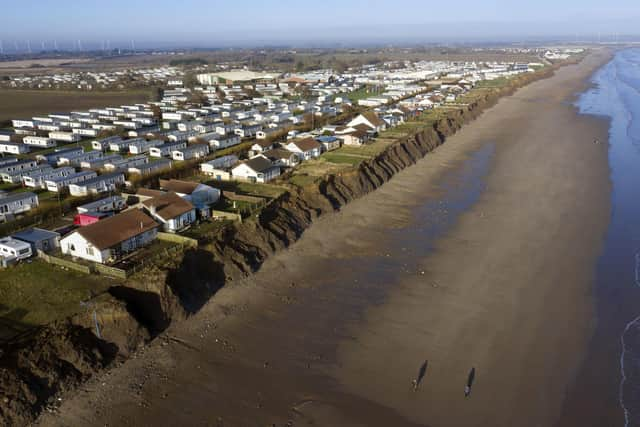'Innovative' ways to help homeowners whose properties are on the brink of falling into the sea
It is forecast that 103 homes could be lost to the sea by 2105, with 16 coming under threat by 2025.
Some 31 miles (50km) of Yorkshire’s coastline is made up of undefended boulder clay cliffs. The fastest eroding coastline in Europe, the worst affected stretch between Withernsea and Hollym has been lost to the sea at an average rate of 14ft (4.27m) a year since 1989.
Advertisement
Hide AdAdvertisement
Hide AdHowever a committee heard over the last decade the rate has sped up, with up to 20ft (6m) being lost in the summer, and 39ft (12m) in the winter of 2021 to 2022.


East Yorkshire and North Norfolk contain 84.1 per cent of all homes at risk of coastal erosion in the next 20 years.
The two councils have been awarded government funding to work with coastal communities that cannot sustainably be defended from coastal erosion and explore innovative ways to help those at risk.
Homeowners in East Yorkshire can’t get compensation and can only apply for limited financial help, the committee heard, including the cost of demolishing their properties – anything between £6,000 for a small bungalow to £80,000 for a farmhouse with outbuildings and “asbestos everywhere”. But having lost the capital invested in their homes, they often end up in council or private rented accommodation.
Advertisement
Hide AdAdvertisement
Hide AdThe council has a policy which allows homes and businesses to “roll back” inland, but a committee heard that the two biggest barriers were the cost of buying the land and construction.
That left many people staying in their property “until the last minute”, councillors were told.
Coastal change manager Richard Jackson told the environment and regeneration sub-committee they didn’t have all the answers.
However he said: “This funding can pay for land purchase and construction costs which have been two of the main barriers to people relocating – that’s a real positive from my perspective.”
Advertisement
Hide AdAdvertisement
Hide AdIt won’t mean the council buying land and giving it to people with councillors told there “has to be an element of these things starting to pay for themselves”.
Afterwards committee chairman Richard Meredith said the council already did more to help clifftop dwellers than it was legally required to do. He said: “This will allow it to do even more."
The plans are still in draft form, but shared ownership schemes could be an answer.
East Riding Council already runs shared ownership schemes where people can buy shares in the property – usually around 50 per cent – with rent paid on the remaining share.
Advertisement
Hide AdAdvertisement
Hide AdBuyers are able to purchase further equity shares through a process known as "staircasing” until they end up owning the property outright. Most of the coast, outside the built-up areas of Bridlington, Withernsea and Hornsea, have been left undefended for decades as a result of a "do nothing" policy, agreed by successive Governments
